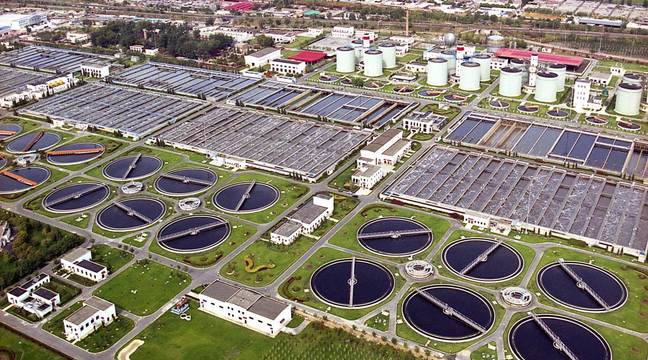
当前课程知识点:Water and Wastewater Treatment Engineering: Biochemical Technology > Chapter 5 Wastewater Anaerobic Biological Treatment Process > Section 5.4 UASB process > Section 5.4 UASB process
返回《Water and Wastewater Treatment Engineering: Biochemical Technology》慕课在线视频课程列表
返回《Water and Wastewater Treatment Engineering: Biochemical Technology》慕课在线视频列表
同学们好!今天我们来学习第5章的第4节,UASB工艺
UASB是指Upflow Anaerobic Sludge Bed Reactor或者也有人用Blanket
那么它简称呢,UASB 反应器,它是在上世纪70年代
由荷兰Wageningen农业大学的Gatze Lettinga教授
在上流式厌氧滤池的基础上开发出来的
这是UASB反应器的工作原理示意图
废水从UASB反应器的底部进入通过进水配水系统均匀分布在反应器的底部
并向上流动经过反应区,反应区呢
主要是由厌氧活性污泥组成,通常情况下
在UASB反应器内能够形成沉淀性能和生物活性都非常高的颗粒污泥
同时也存在着一定的悬浮污泥
废水中的有机物在反应区内被厌氧微生物所降解
最终转化成为甲烷和二氧化碳,形成沼气气泡
跟废水和污泥形成的混合液呢,继续向上进入三相分离器
这里的“三相”,是指气、固、液三相,分别是沼气、污泥和废水
在三相分离器中,沼气气泡被收集进入集气罩,并最终被引出反应器
污泥被截流并返回到反应区,废水则继续向上进入沉淀区
并最终通过出水系统排出反应器
那么因此,我们可以看到,UASB反应器的工艺特征,主要有如下几点
第一呢,是在反应器的上部,设置了气、固、液三相分离器
在反应器底部呢设置了均匀布水系统
那么由于采用向上流的这种流动方式
在反应器的内部呢,它的污泥呢,通常能够形成颗粒污泥
这些污泥的直径呢,一般是在0.1到0.5个厘米之间
湿比重呢,在1.04到1.08之间,具有非常好的沉降性能
还具有非常高的生物活性,也就是特指的产甲烷的活性
那么污泥的浓度呢,可以达到50gVSS/L以上
污泥龄呢,一般在30天甚至呢,有的在几百天以上
那么由于这样的一个基础条件呢
可以使得UASB反应器的水力停留时间大大缩短
具有非常高的容积负荷
它可以处理各种高浓度、中浓度的有机工业废水
甚至呢,也可以处理低浓度的城市污水
这个反应器呢,将生物反应跟沉淀分离呢,集中在一个反应器内
那么结构呢,紧凑,而且呢,跟前面的生物滤池相比
它不需要设置填料,节省了费用,提高了容积利用率
那么UASB反应器呢,有多种型式
我们从断面上来看呢,它可以分成圆形的或者是矩形的
那么矩形断面呢,一般呢,便于这个三相分离器的设计和施工
对于圆形的呢,要采用特别的这个三相分离器的形式,那么通常呢
可以用钢结构或者是钢筋混凝土的结构来做这个反应器的主体
一般呢,在反应器的内部,不设置加热
但是呢,通常采用保温的措施,必要的时候呢,对进水进行加热
主要呢,从型式上来分呢 ,可以有两种型式
一种呢,我们称为开敞式的UASB反应器
一种呢,我们称为封闭式的UASB反应器
那么这个图呢,给出的就是开敞式的UASB反应器的一个结构示意图
通常呢,在顶部不加密封,或者是仅加一层呢,不太密封的这种盖板
那么多用于处理中等浓度或者低浓度的有机废水
结构呢,较为简单,易于施工安装和维修
那么这张图呢,给出的是这种封闭式的UASB反应器的结构示意图
那么在顶部呢,加盖密封
基本上是沿用了这个厌氧消化池的一个结构形式
在液面和池顶之间呢,会形成这个沼气的气室
适用于呢,处理高浓度的有机工业废水
那么它的顶部呢,可以参照厌氧消化池呢
可以做成这种浮动盖式的,在反应器内
能形成沉降性能良好、生物活性高的颗粒污泥是UASB反应器的一个重要特征
颗粒污泥的形成跟成熟,是保证UASB反应器高效稳定运行的一个基本前提
那么这里面给出了一些颗粒污泥形成过程中间一些这个图片
可以看出呢,这个反应器呢,是在运行到第77天的时候
我们从反应器呢,取得颗粒污泥,可以看到呢
已经形成了初步的颗粒污泥,它的粒径呢,在0.5个毫米之间
那么随着运行的进展,时间的延长呢,颗粒污泥逐渐成熟
到120天的时候呢,我们可以看到
颗粒污泥的粒径已经接近一个毫米,而且在颗粒的表面呢
有大量的这种典型的这个甲烷丝状菌
这张图片给出的是其他研究者培养出来的不同形式的颗粒污泥
那么有在中温下和在高温下,都能够培养出厌氧颗粒污泥
好,那么第五点呢,我们来介绍UASB反应器的设计计算
目前来说呢,没有正式发布的完整的关于UASB反应器的工程设计计算的方法
但是呢,主要的内容呢,还是包括这样三个方面
第一呢,是池型的选择,以及有效容积的确定和主要部位的关键尺寸的确定
第二是要设计进水配水系统、出水系统和三相分离器
第三呢,是其它的辅助系统的设计,包括排泥,排渣等
那么关于UASB反应器容积的确定呢
目前多采用容积负荷法来进行确定
那么具体的计算公式呢,放在这,可以看呢
主要是在确定了进水流量和进水浓度以后呢
在你确定了容积负荷的基础上,就可以用这个公式呢
直接计算出,反应器的需要的总容积
那么这个总容积呢,是包含了反应区和沉淀区的
那么容积负荷呢,跟反应温度、废水的性质
以及呢,能否形成颗粒污泥呢,直接相关
对于食品工业废水或者是跟它性质相近的一些废水呢
一般可以用下面这个表的给出的一些参考值呢
进行这个设计计算,可以看到呢
在这个表中,如果你采用高温的话,容积负荷呢
可以在20到30kgCOD/(m3·d)
如果是采用中温条件下来运行呢,容积负荷呢
一般是在10到20kgCOD/(m3·d)
这里所说的常温条件呢,一般指的是在20°左右
那么它的负荷呢,就只能采用5到10kgCOD/(m3·d)
如果不能够保证达到20°,我们建议呢
你的容积负荷呢,只能在2到5kgCOD/(m3·d)之间来进行选择
那么另外一个呢,是关于这个进水配水系统的设计
这是对UASB反应器的运行呢,是非常至关重要的
我们希望呢,将所有的进水均匀的分布在反应器的底部
那么在目前来说呢,有多种这个进水系统的方式
第一种呢,我们是可以考虑采用脉冲式布水还是连续式的布水
那么实际上是在UASB的顶部,采用一个进水罐
当这个罐达到一定水位以后呢,会一次性的将这一罐的水
投配到反应器内部去,那么也有考虑呢
我们在底部采用穿孔管或者是分枝管
或者呢,我们直接在上部采用一管一孔式的这个布水
那么另外一个更关键的设备呢
在于UASB反应器中间呢,是三相分离器
那么三相分离器呢,基本的构造型式有这样三种型式
那么这个示意图呢,给出了三相分离器的一个细部的一个原理图
我们的设计计算呢,就要保证在B点的一个气泡
一个沼气气泡呢,不能够随着水流进入到上部的沉淀区
那因此呢,我们在这给出了它的一个限制性的条件
用这个公式来表示,那么其中呢,沼气气泡的这个上升流速
可以用Stokes公式来进行计算,那么设计好了以后呢
我们就能够确保一个直径是0.1毫米的气泡都不至于呢
进入沉淀区,那么这样的话呢
就能够确保沼气呢,完全被收集
而且呢,沼气气泡呢,不会进入沉淀区,导致对沉淀区的影响
那么关于这个三相分离器的设计计算呢
我们还有一些基本的要求,好比说,上部的沉淀区
我们要保证它的表面负荷呢,要小于1.0m3/(m2·h)
因为它就相当于二沉池,那么另外集气罩斜面的坡度呢
应该是在55°到60°之间
因为我们要确保在沉淀区沉淀下来的污泥呢,还能够回到反应区
在沉淀区的总的水深呢,应该不小于1.5m
能够确保水流在这里面停留的时间
沉淀区的停留时间呢,我们希望能够维持在1.5到2.0h
那么除此之外呢,还需要设计回流缝
还需要设计气液分离
这里给出一些我们常用的这个三相分离器的形式
那么除了三相分离器的设计以外呢,其他的UASB中间的设计呢
我们还有涉及到,沼气的收集与利用
还有呢,出水系统的设计,另外是在反应器内,可能会形成浮渣
那么我们要对浮渣进行及时的清除
所以我们要设计这个浮渣清除系统
另外的话呢,虽然我们说在厌氧过程中间
剩余污泥的产量比较低,一般呢,不需要经常的排泥
但是呢,当UASB反应器运行时间足够长的时候
它还会积累出一些剩余污泥,我们也需要设计排泥系统
另外的话呢,我们就需要设计加温
最后一点呢,就是我们需要确保UASB反应器的温度的话
我们需要设计加热系统,或者说是保温系统
另外呢,在反应器的内壁,还要设计这个防腐系统
好,这节内容就到这,谢谢
-Section 0.1 Development Status of Wastewater Treatment Process
--Section 0.1 Development Status of Wastewater Treatment Process
-Section 0.2 Typical Processes of Wastewater Biological Treatment
--Section 0.2 Typical Processes of Wastewater Biological Treatment
-Section 1.1 Principles of wastewater aerobic biological treatment
--1.1 Principles of wastewater aerobic biological treatment
-Section 1.2 Principles and determination of wastewater biodegradability
--1.2 Principles and determination of wastewater biodegradability
-Section 1.3 Principles of wastewater anaerobic biological treatment
--Section 1.3.1 Principles of wastewater anaerobic biological treatment(1)
--Section 1.3.2 Principles of wastewater anaerobic biological treatment(2)
-Section 1.4 Principles of wastewater biological nitrogen removal
--Section 1.4 Principles of wastewater biological nitrogen removal
-Section 1.5 Principles of wastewater biological phosphorus removal
--Section 1.5 Principles of wastewater biological phosphorus removal
-Chapter 1 Homework
-Section 2.1 Basic concept of activated sludge process
--Section 2.1.1 Basic concept of activated sludge process
--Section 2.1.2 Basic concept of activated sludge process
-Section 2.2 Growth rule of activated sludge and its application
--Section 2.2 Growth rule of activated sludge and its application
-Section 2.3 Running mode of activated sludge process
--Section 2.3.1 Running mode of activated sludge process(1)
--Section 2.3.2 Running mode of activated sludge process(2)
-Section 2.4 Kinetics of active sludge process
--Section 2.4.1 Kinetics of active sludge process(1)
--Section 2.4.2 Kinetics of active sludge process(2)
--Section 2.4.3 Kinetics of active sludge process(3)
--Research and Development of Kinetic Model of Activated Sludge Process
-Section 2.5 Principle, calculation and equipment of aeration
--Section 2.5.1 Principle, calculation and equipment of aeration(1)
--Section 2.5.2 Principle, calculation and equipment of aeration(2)
-Section 2.6 Designing of activated sludge process
--Section 2.6 Designing of activated sludge process
-Section 2.7 Operation and management of active sludge process
--Section 2.7.1 Operation and management of active sludge process (1)
--Section 2.7.2 Operation and management of active sludge process (2)
-Chapter 2 Homework
-Section 3.1 Basic principle of biofilm
--Section 3.1 Basic principle of biofilm
-Section 3.2 Biofilter process
--Section 3.2.1 Biofilter Process (1)
--Section 3.2.2 Biofilter process (2)
--Section 3.2.3 Biofilter process (3)
-Section 3.3 Biodisk process
-Section 3.4 Biological contact oxidation process
--Section 3.4 Biological contact oxidation process
-Section 3.5 Aerobic biological fluidized bed process
--Section 3.5 Aerobic biological fluidized bed process
-Chapter 3 Homework
-Section 4.1 Oxidation ditch process
--Section 4.1 Oxidation ditch process
-Section 4.2 A-B process
-Section 4.3 SBR process
-Section 4.4 MBR process
-Chapter 4 Homework
-Section 5.1 Overview and characteristics of development of anaerobic biological treatment
--Section 5.1 Overview and characteristics of development of anaerobic biological treatment
-Section 5.2 Anaerobic digester
--Section 5.2 Anaerobic digester
-Section 5.3 Anaerobic contact process and anaerobic filter process
--Section 5.3 Anaerobic contact process and anaerobic filter process
-Section 5.4 UASB process
-Section 5.5 Other anaerobic biological treatment process
--Section 5.5 Other anaerobic biological treatment process
-Section 5.6 Operation management of anaerobic biological treatment process
--Section 5.6 Operation management of anaerobic biological treatment process
-Chapter 5 Homework
-Section 6.1 Introduction
-Section 6.2 Biological nitrogen removal process and technology
--Section 6.2 Biological nitrogen removal process and technology
-Section 6.3 Biological phosphorus removal process and technology
--Section 6.3 Biological phosphorus removal process and technology
-Section 6.4 Simultaneous nitrogen and phosphorus removal process
--Section 6.4 Simultaneous nitrogen and phosphorus removal process
-Chapter 6 Homework
-Section 7 Natural biological treatment process
--Section 7 Natural biological treatment process
-Chapter 7 Homework
-Section 8.1 Source, nature and treatment of sludge
--Section 8.1 Source, nature and treatment of sludge
-Section 8.2 Sludge thickening and digestive stability
--Section 8.2 Sludge thickening and digestive stability
-Section 8.3 Sludge conditioning, dehydration and incineration
--Section 8.3 Sludge conditioning, dehydration and incineration
-Chapter 8 Homework
-Section 9 Wastewater Discharge and Reuse
--Section 9 Wastewater Discharge and Reuse
-Chapter 9 Homework
